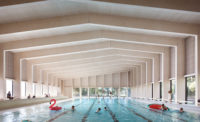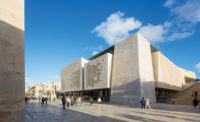Few architects get to build in the center of Palma, capital of the Spanish island of Mallorca. For local practice OHLAB, the commission to design an upscale apartment complex on the Paseo de Mallorca, a tree-lined boulevard leading to the city’s yacht harbor, was a privilege that carried a strong sense of obligation. “The client was very ambitious and wanted a landmark,” says Jaime Oliver, who leads the firm with his wife, Paloma Hernaiz. “We also felt a responsibility to reflect the urban and cultural context—to be in dialogue with neighbors and to revive aspects of Mediterranean vernacular architecture that have fallen out of fashion.” Equally important was OHLAB’s determination to set a new standard for energy performance in multifamily housing on the island.

1

2
Wrapped in panels of slatted pine, the building’s central eightstory wing dominates a corner (1 & 2), while, on the side streets, six- and four-story sections are clad with ribbed GFRC panels. Photos © José Hevia, click to enlarge.
Each of those concerns is addressed through the design of layered facades that create a unique, richly textured, and ever-changing appearance. Occupying one corner of a triangular urban block, the brick and concrete building comprises three distinct pieces: on the Paseo, facing east, an eight-story structure dominates the site, wrapped in a delicate brise soleil of vertically slatted Spanish pine that recalls traditional Mallorcan shutters. More than 350 fixed and sliding panels shade full-height glazing in the open-plan living areas of all 10 apartments. By day, the patterning of these openings varies with the seasons and the movement of the sun; by night, electric light spills from within as through a wicker lantern.

3

4
In the units, sliding glass doors behind the slats abet daylight and fresh air, and activate the facade (3 & 4). Photos © José Hevia
Two lower wings (one six stories, the other four) face onto narrow side streets and enclose a central landscaped courtyard, giving greater privacy to the bedrooms looking on to it. Clad in slabs of glass-fiber-reinforced concrete that frame deep-set windows, they have a material weight and toughness that counterposes the lightness of the wood-slat expanses. Gnarled ribs cast into the face of each panel pick up on the rhythm of the timber screens and lend the appearance of fresh-hewn stone.

A courtyard is visible through the glazed entrance of Paseo Mallorca 15. Photo © José Hevia
Beneath these contrasting skins, the whole envelope is designed to Passive House standards, with high levels of insulation and airtightness. It’s an approach often associated with more temperate regions, but also suits the Mallorcan climate, where hot summer nights sometimes preclude natural airflow and winter temperatures can drop to 45 degrees Fahrenheit. OHLAB first tested this strategy at Casa MM, also in Mallorca, which was selected as a Record House. “To this day,” says Oliver, “the owners have never turned on the air-conditioning or the heating.”
At Paseo Mallorca 15, the combination of Passive House measures and careful shading—reinforced by cross ventilation and a heat-recovery system—reduces heating and cooling loads by almost 90 percent, relative to conventional buildings. “The important principle is that direct sun cannot touch the interior in the summer, but filters through to warm the space in winter,” says Oliver. “That’s a simple idea, and a traditional way of designing, but few people do it now.”
Having roughed out the shading design by intuition, OHLAB refined it in a 3D digital model, adjusting the depth, thickness, and orientation of louvers across the facades. The consequent variety should also allow the wooden veil to age gracefully. “It’s already ‘imperfect,’ ” says Oliver, “so some movement over time won’t look like a defect.”
There’s a similar mix of sophistication and near-rustic simplicity inside, beginning at the glass-fronted entrance lobby on one of the quiet side streets. Rugged concrete walls within are warmed by wood paneling inset with beautiful handcrafted mailboxes. Lush planting runs from the sidewalk through the foyer; ferns and evergreen reeds that sprout from gaps in the paved floor echo the verdant banks of a river that flows down the Paseo. In the courtyard beyond, a gentle waterfall is intended to cool the air. It cascades to a lower terrace excavated to provide light and air to a basement gym and stone-lined swimming pool. “That’s one of many ways that this building is a little different,” says Hernaiz. “Communal facilities are normal in northern Europe, but not in Mallorca.”

Wood complements the concrete and plantings in the lobby. Photos © José Hevia

OHLAB also challenged norms of the high-end property market to specify its preferred finishes in the apartments, which range from 1,000 to 3,230 square feet. “There is a perception here that local or natural materials are inferior—that modern aluminum windows are better than wood,” says Oliver. “We are convinced that it is right to use wood, for environmental reasons, for the way they patinate over time, and for the sensory experience.” The palette includes Mallorcan stone fashioned into kitchen countertops and weighty bathroom basins, and an assortment of woods, from oak and walnut to the fragrant cedar used in the closets. Walls are finished in unpainted lime plaster. “When you touch them, you can sense the heaviness of the brick behind,” says Hernaiz. “For us, that’s what luxury means today: unpretentious, calm, and comfortable, with attention paid to all the little things.”

5
A penthouse features an open living area (5), well-appointed kitchen (6), and double-height dining area (7). Photos © José Hevia

6

7

8
The residence opens to a rooftop terrace and swimming pool (8). Photo © José Hevia
There are, it must be said, plenty of conventional indulgences in the building, from the glass elevator car serving three floors of basement parking to outdoor infinity pools, one each on three landscaped roof terraces serving the penthouses. But OHLAB insists that some of the building’s best qualities are easily replicable in more modest projects. “This kind of low-energy building just feels right,” says Hernaiz. “Everything from the play of light to the quality of the air is nicer.” Certainly the once skeptical client is convinced. “He says Passive House is now in his DNA—he’ll never build anything else,” she reports. “As architects who feel responsible to spread the message of sustainable design, that makes us very proud.”
Click plans to enlarge

Click drawing to enlarge

Credits
Architect:
OHLAB/Oliver Hernaiz Architecture Lab — Paloma Hernaiz, Jaime Oliver, Rebeca Lavín, Robin Harloff, Loreto Angulo, Pedro Rodríguez, Silvia Morais, Mercé Solar, M. Bruna Pisciotta, Tomislav Konjevod, José Allona, Claudio Tagarelli, Eleni Oikonomaki, Agustín Verdejo y Luis Quiles, design team
Engineers:
Bartolomeu Tous (building); HIMA Estructuras (structural); M&E Engineering (facilities)
Consultants:
AMM Technical Group (engineering); José Manuel Busquets, Anne Vogt (energy efficiency); Jonathan Bell (landscape)
Client:
Ramis Promociones
Size:
46,300 square feet
Cost:
Withheld
Completion Date:
January 2021
Sources
GFRC Facade:
Prehorquisa
Wood Facade:
Grupo GUBIA
Wood-Frame Windows:
Carinbisa
Custom Woodwork:
Nord I Sapi
Surfaces:
Contract Stone (local stone); New Yam Design (wood); UNICMALL (lime mortar on walls)




